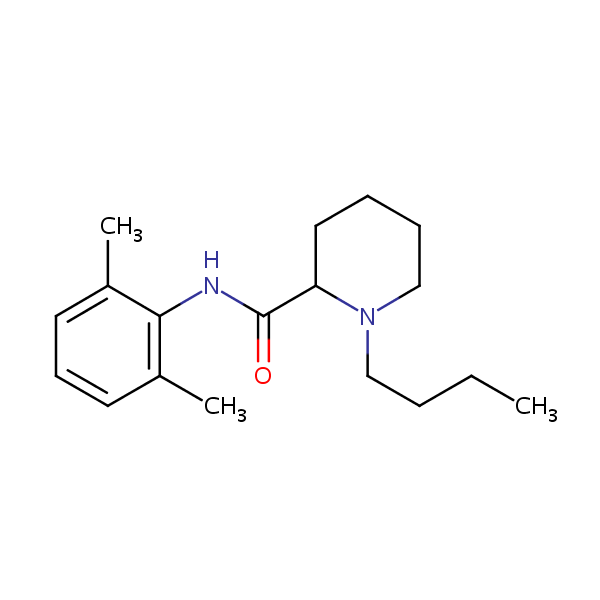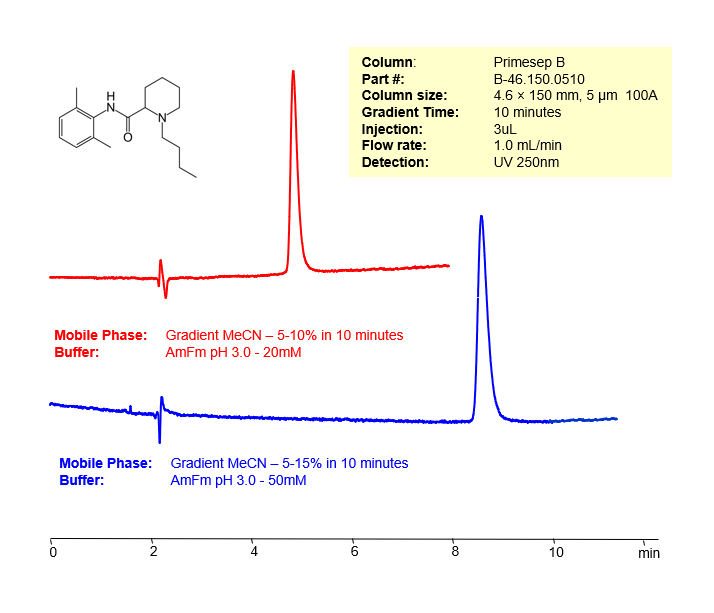| CAS Number | 38396-39-3 |
|---|---|
| Molecular Formula | C18H28N2O |
| Molecular Weight | 288.435 |
| InChI Key | LEBVLXFERQHONN-UHFFFAOYSA-N |
| LogP | 3.41 |
| Synonyms |
|
Applications:
HPLC Method for Analysis of Bupivacaine on Primesep B Column
June 6, 2023
HPLC Method for Analysis of Bupivacaine on Primesep B by SIELC Technologies
Separation type: Liquid Chromatography Mixed-mode
Bupivacaine is a type of medication known as a local anesthetic. It works by blocking nerve impulses that send pain signals to your brain, numbing the area and reducing discomfort. This drug is most commonly used during surgical procedures, labor and delivery, or dental procedures. Bupivacaine is often injected into the area of the body where pain relief is needed.
Bupivacaine comes in various forms, including an injectable solution and a topical patch. It has a longer duration of action compared to some other local anesthetics, making it particularly useful for procedures that may require prolonged anesthesia or postoperative pain management.
As with any medication, bupivacaine can have side effects and potential risks. These can include low blood pressure (hypotension), irregular heart rhythms (arrhythmias), and in rare cases, severe reactions like seizures or cardiac arrest. Therefore, it’s crucial to only use bupivacaine under the direct supervision of a healthcare provider.
Bupivacaine can be analyzed on a reverse-phase Primesep B, 4.6 x 150 mm, 5 µm, 100 A column with a mobile phase consisting of water, Acetonitrile and Ammonium formate as a buffer modifier. This analysis method can be UV detected at 250 nm.
High Performance Liquid Chromatography (HPLC) Method for Analysis of Bupivacaine
Condition
| Column | Primesep B, 4.6 x 150 mm, 5 µm, 100 A |
| Mobile Phase | MeCN gradient |
| Buffer | AmFm pH 3.0 |
| Flow Rate | 1.0 ml/min |
| Detection | UV 250 nm |
Description
| Class of Compounds | Anesthetics, Amide |
| Analyzing Compounds | Bupivacaine |
Application Column
Primesep B
Column Diameter: 4.6 mm
Column Length: 150 mm
Particle Size: 5 µm
Pore Size: 100 A

HPLC Method for Analysis of Bupivacaine on Primesep 200 Column
May 10, 2016
Separation type: Liquid Chromatography Mixed-mode
HPLC Method for Analysis of Bupivacaine on Primesep 200 by SIELC Technologies

Bupivacaine is a local anesthetic drug. It belongs to the amide group of local anesthetics and is used to block nerve impulses, thereby reducing pain and discomfort in a specific area of the body.
Bupivacaine can be administered through injection or via a topical solution, depending on the procedure. It is often used for surgical, dental, and obstetric procedures, and can also be used for the treatment of chronic pain.
The onset of action of bupivacaine is relatively rapid (1-4 minutes depending on use), and its effects can last for several hours, making it useful for procedures that require a long duration of anesthesia.
Bupivacaine can have significant side effects and risks, particularly if it enters the bloodstream, and it should always be administered by a qualified healthcare provider. These side effects can include cardiovascular issues, central nervous system effects, and allergic reactions.
Bupivacaine can be analyzed on a reverse-phase Primesep 200, 3.2 x 100 mm, 5 µm, 100 A column with a mobile phase consisting of water, Acetonitrile (MeCN) and Phosphoric acid as a buffer modifier. This analysis method can be UV detected at 270 nm.
High Performance Liquid Chromatography (HPLC) Method for Analysis of Bupivacaine
Condition
| Column | Primesep 200, 3.2 x 100 mm, 5 µm, 100 A |
| Mobile Phase | Gradient MeCN – 5-50% |
| Buffer | Gradient H3PO4 – 0.05-0.3%, 5 min, 4 min hold |
| Flow Rate | 0.5 ml/min |
| Detection | UV, 270 nm |
| Class of Compounds | Drug, Anesthetic, Acid, Hydrophilic, Ionizable, Vitamin, Supplements |
| Analyzing Compounds | Bupivacaine |
Application Column
Primesep 200
Column Diameter: 3.2 mm
Column Length: 100 mm
Particle Size: 5 µm
Pore Size: 100 A





